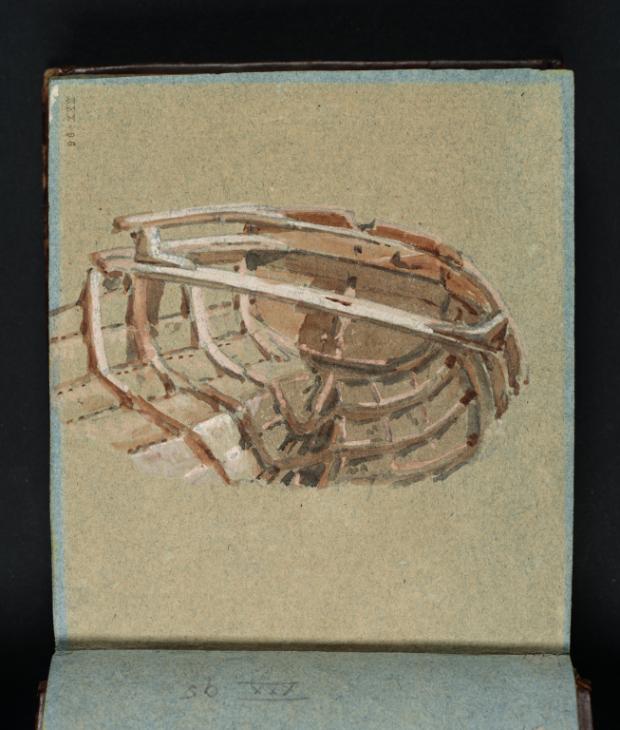Joseph Mallord William Turner Study of the Inside of a Small Boat: Transom, Thwart and Ribs 1796
Joseph Mallord William Turner,
Study of the Inside of a Small Boat: Transom, Thwart and Ribs
1796
Joseph Mallord William Turner 1775–1851
Folio 94 Verso:
Study of the Inside of a Small Boat: Transom, Thwart and Ribs 1796
D00841
Turner Bequest XXX 96
Turner Bequest XXX 96
Pencil, watercolour and gouache on blue laid paper, 126 x 108 mm
Stamped in black ‘XXX – 96’ top left, descending vertically
Stamped in black ‘XXX – 96’ top left, descending vertically
Exhibition history
1904
National Gallery, London, various dates to at least 1904 (534c, as ‘Foreshortened Study of Stern of Rowing Boat’).
References
1904
E.T. Cook and Alexander Wedderburn (eds.), Library Edition: The Works of John Ruskin: Volume XIII: Turner: The Harbours of England; Catalogues and Notes, London 1904, p.634 no.534(c), as ‘Foreshortened Study of Stern of Rowing Boat’.
1909
A.J. Finberg, A Complete Inventory of the Drawings of the Turner Bequest, London 1909, vol.I, p.62, XXX 96, as ‘Study of stern of rowing boat.’.
2003
Susan Sloman, Watercolours & Drawings: Agnew’s 130th Annual Exhibition, exhibition catalogue, presented by Andrew Wyld for Thos. Agnew & Sons, London 2003, p.[26] under no.31.
Technique and condition
This watercolour is in the small-scale Studies near Brighton sketchbook (Tate; Turner Bequest XXX) made from several sheets each of white wove Whatman paper and strong blue laid wrapping paper. The paper was made blue by the inclusion of coloured fibres, mainly from blue rags. This sketchbook was probably bound by William Dickie at 120 Strand, London, who bound many of Turner’s sketchbooks, often using paper supplied by Turner himself. A similar blue paper is found in the Wilson sketchbook (Tate; Turner Bequest XXXVII). In the Studies near Brighton sketchbook Turner also prepared some of the blue pages with a red wash, while in the Wilson sketchbook every page was so treated, and Turner may have done this himself before the book was bound.1 The Wilson sketchbook would have had deep red-brown pages originally, all which have lost colour. Its red wash was applied with glue size, probably brushed on hot for ease of application. This sizing and the somewhat unusual presence of wool fibres in the paper in addition to the more common linen ones gave a very strong paper which could survive vigorous brushwork and repeated soaking during the painting process.2
Here Turner chose a blue page, which has subsequently been exposed to so much light that the blue fibres in the paper have faded, while the predominating white fibres have yellowed.
The spars of the boat were outlined lightly with a fine graphite pencil before washes of watercolour made from brown ochres, and opaque gouache made from lead white, were applied to form the spars. The spars remain bluish and slightly flecked in appearance because the gouache has protected the blue paper beneath. The larger blocks of colour for the stern were added next, along with more localised grey washes for the shadows of the spars on the right. These transparent washes were less protective. Their impact would have been greater when their warm tones could have been viewed against the cool pale blue paper. All the washes were applied to dry paper and have dried with visible edges – necessarily, when Turner was working with a sketchbook instead of loose sheets of paper.
The sketch was catalogued by Finberg as ‘sepia and Chinese white’, a description which broadly conveys the perceived colours but does not characterise the materials accurately. Turner habitually used lead white, a very dense white albeit poisonous pigment, for gouache in both early and late watercolours. ‘Chinese white’ in fact refers to a brand of zinc white pigment first marketed in 1834. Previous zinc white products could only create semi-transparent, anaemic whites when used in watercolour. Turner did try out this material early in his life, and it is one of the few pigments he virtually never used again, which suggests he was disappointed with the effects it produced even against a coloured background.
Helen Evans
October 2008
Revised by Joyce Townsend
February 2011
How to cite
Helen Evans, 'Technique and Condition', October 2008, revised by Joyce Townsend, February 2011, in Andrew Wilton, ‘Study of the Inside of a Small Boat: Transom, Thwart and Ribs 1796 by Joseph Mallord William Turner’, catalogue entry, May 2011, in David Blayney Brown (ed.), J.M.W. Turner: Sketchbooks, Drawings and Watercolours, Tate Research Publication, November 2014, https://wwwThis study was made with the page turned vertically. Susan Sloman cites Ian Warrell as pointing out that Turner used it for the detail of a decayed boat in the foreground of his contemporary view of Brighthelmstone (later Brighton; private collection).1 Compare folio 95 verso (D00840; Turner Bequest XXX 95), which shows the bow of the same boat.
Finberg recorded this subject as the recto; see the Technical notes to the sketchbook’s Introduction.
Technical notes:
Except at the edges, the page is faded from exposure when it was exhibited.
Andrew Wilton
May 2011
How to cite
Andrew Wilton, ‘Study of the Inside of a Small Boat: Transom, Thwart and Ribs 1796 by Joseph Mallord William Turner’, catalogue entry, May 2011, in David Blayney Brown (ed.), J.M.W. Turner: Sketchbooks, Drawings and Watercolours, Tate Research Publication, November 2014, https://www

